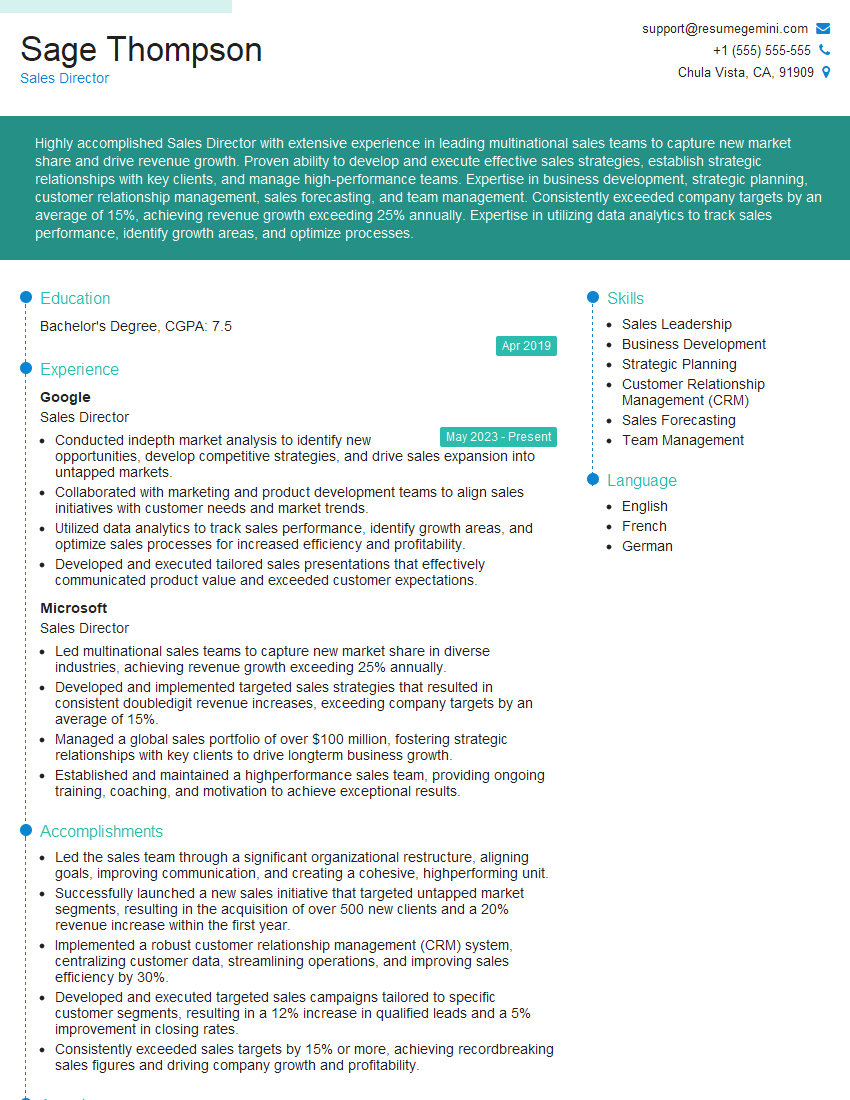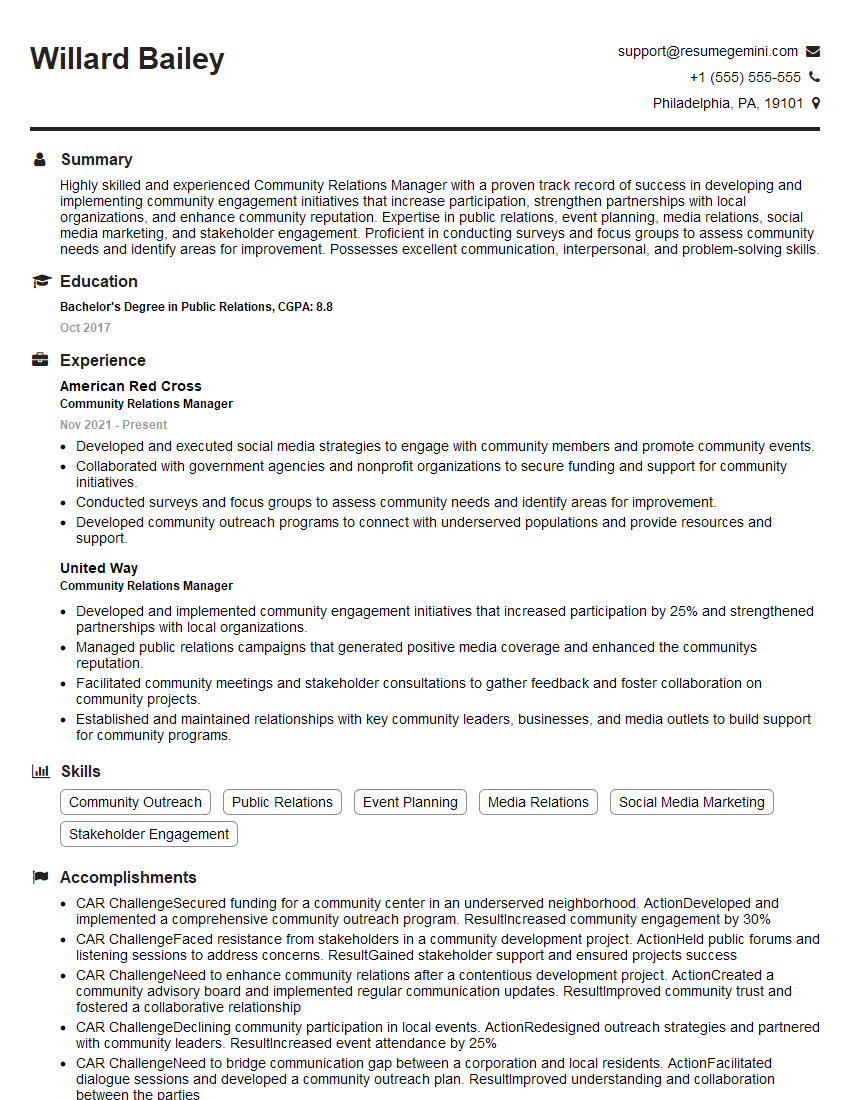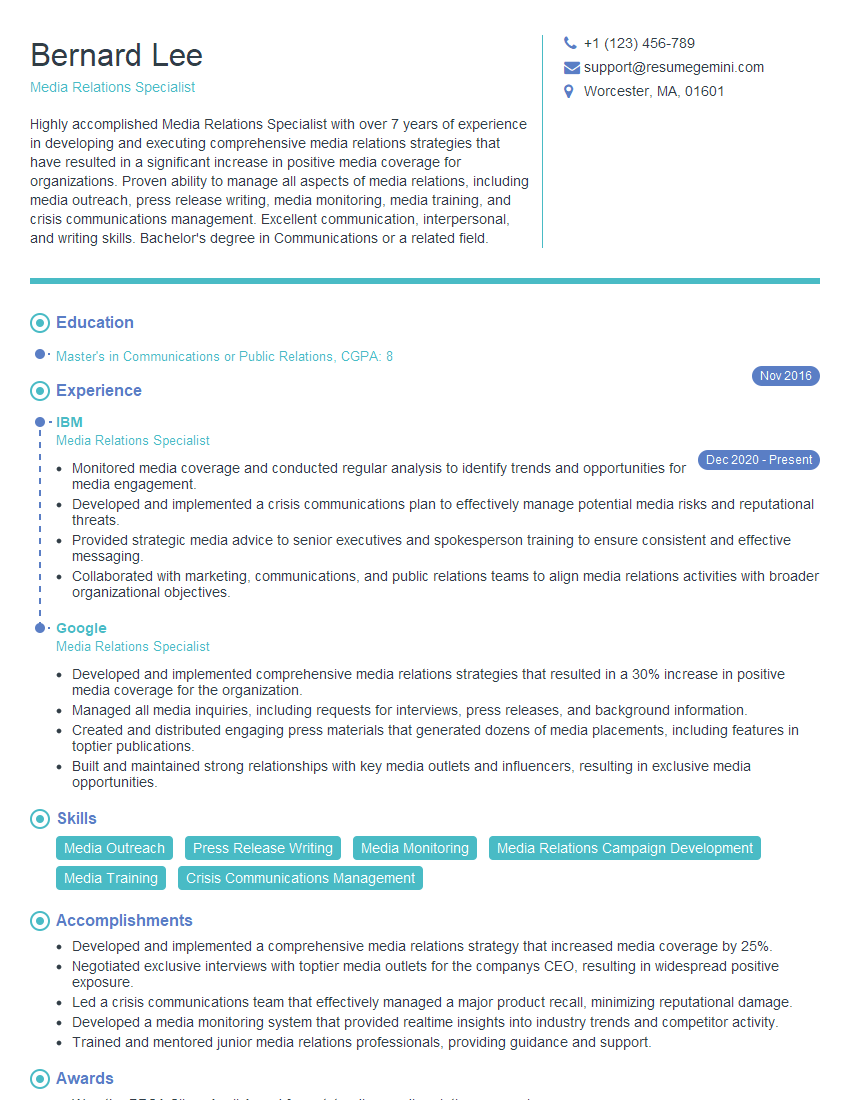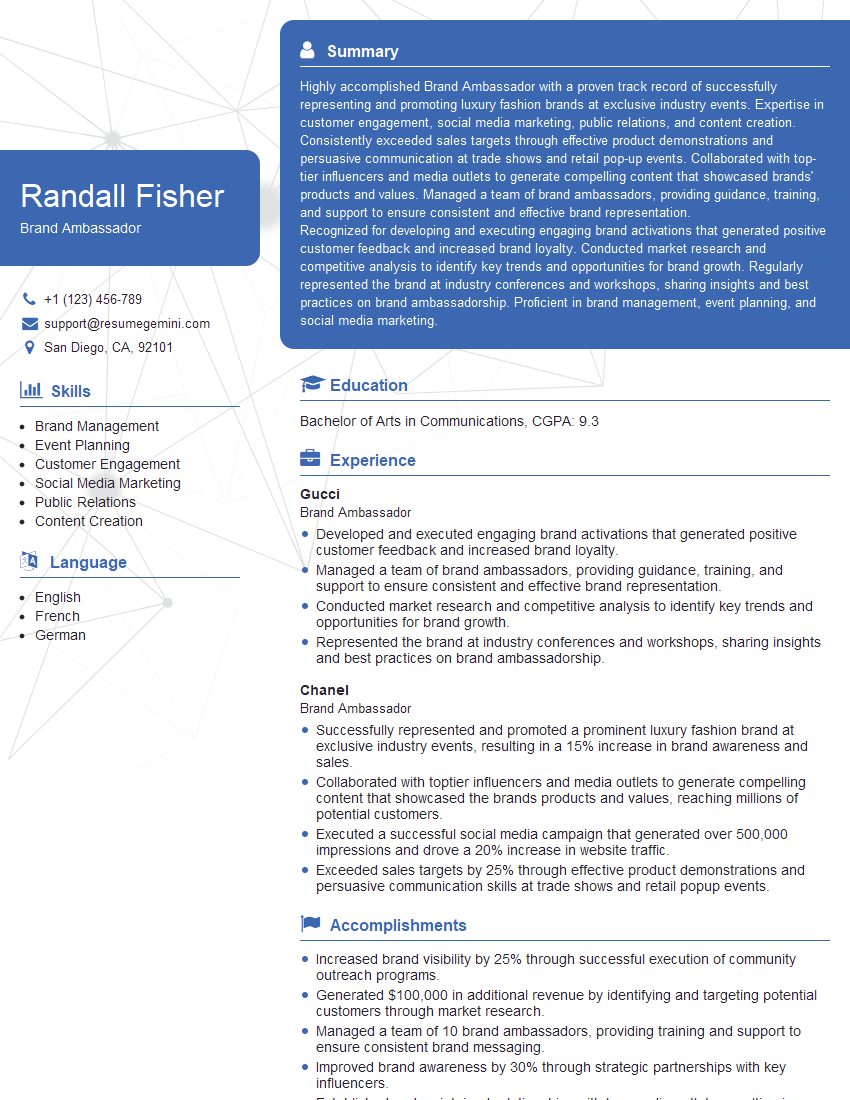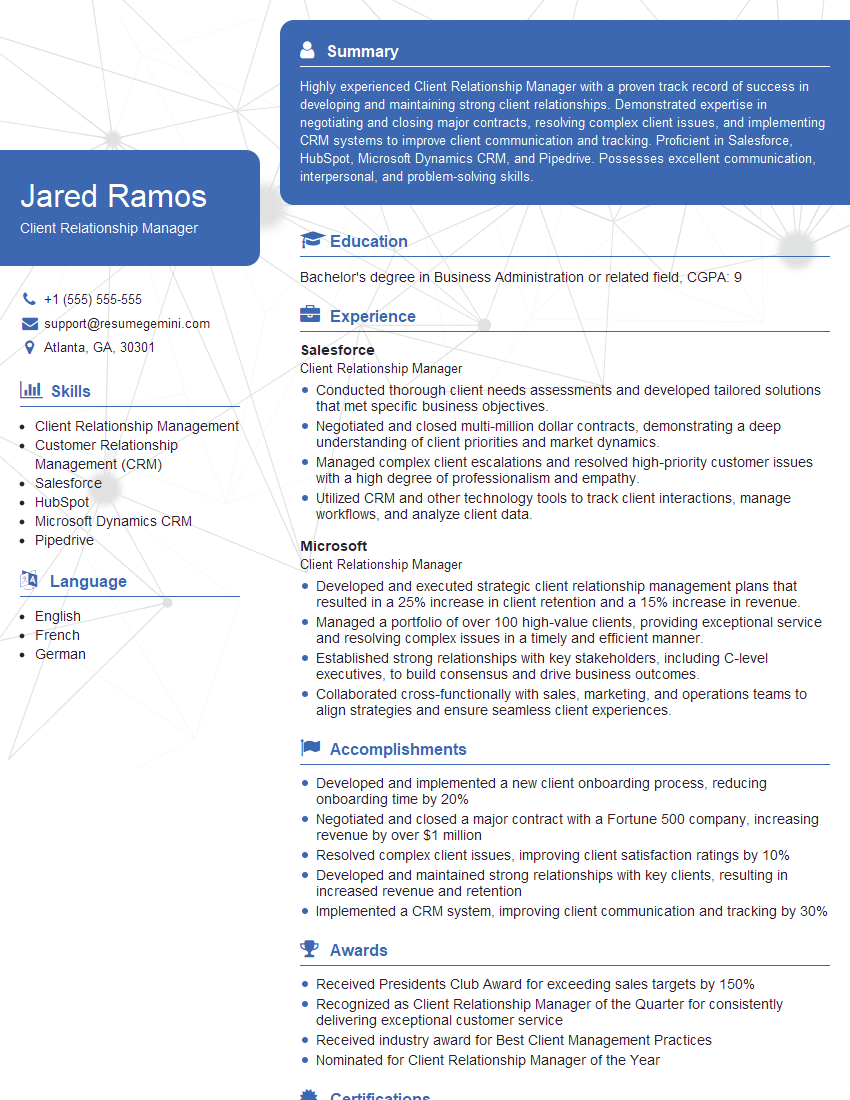Warning: search_filter(): Argument #2 ($wp_query) must be passed by reference, value given in /home/u951807797/domains/techskills.interviewgemini.com/public_html/wp-includes/class-wp-hook.php on line 324
Unlock your full potential by mastering the most common Public Speaking and Client Relations interview questions. This blog offers a deep dive into the critical topics, ensuring you’re not only prepared to answer but to excel. With these insights, you’ll approach your interview with clarity and confidence.
Questions Asked in Public Speaking and Client Relations Interview
Q 1. Describe your experience delivering presentations to large audiences.
I have extensive experience presenting to audiences ranging from small, intimate groups to large-scale conferences with hundreds of attendees. My approach involves meticulous planning and execution, beginning with a thorough understanding of the audience’s background and expectations. I craft compelling narratives that resonate with their interests and needs, structuring the presentation for clarity and impact. For instance, when presenting at a recent industry conference, I incorporated interactive elements like polls and Q&A sessions to maintain audience engagement throughout a 90-minute presentation. This active participation boosted comprehension and fostered a sense of community among the attendees. Beyond the content, I focus heavily on my delivery, incorporating clear vocal projection, purposeful body language, and effective use of visual aids to create a captivating experience.
In larger venues, I leverage technological tools such as microphones, projectors, and presentation software effectively to ensure every audience member has an equally engaging experience. I also rehearse extensively, paying close attention to pacing, transitions, and managing potential technical glitches. This preparation allows me to maintain composure and confidently deliver my message even in high-pressure situations.
Q 2. How do you tailor your communication style to different audiences?
Tailoring communication to different audiences is crucial for effective public speaking and client relations. I adapt my style based on factors like audience size, demographics, level of knowledge, and the context of the presentation or interaction. For instance, when speaking to a technical audience, I would utilize precise terminology and incorporate detailed data, while a presentation to a general audience would necessitate a more simplified and narrative-driven approach.
I often analyze the audience beforehand—researching their interests, understanding their professional background, and gauging their expectations. This allows me to adjust my tone, language, and the overall message to ensure it’s relevant and engaging. Consider, for example, a presentation to a board of directors versus a presentation to new clients. My approach, while maintaining professionalism in both instances, would vary considerably in formality, depth of detail and overall approach.
- Language: Simple and accessible language for a non-technical audience, more technical jargon for experts.
- Tone: Formal and professional for a business setting, more relaxed and conversational for a less formal audience.
- Content: High-level overview for a general audience, detailed information and specifics for specialists.
Q 3. Explain your approach to handling difficult client interactions.
Handling difficult client interactions requires a calm, empathetic, and solution-oriented approach. I begin by actively listening to understand the client’s concerns, validating their feelings without necessarily agreeing with their perspective. This shows respect and builds a foundation for constructive dialogue. I then work to identify the root cause of the issue, focusing on facts rather than emotions. Once the problem is clearly defined, I propose solutions collaboratively, outlining potential options and their implications. The goal is to find a mutually acceptable resolution that meets the client’s needs and aligns with the project’s scope and objectives.
For example, if a client is expressing frustration over a missed deadline, I would first apologize for the inconvenience, then explain the reasons for the delay transparently and honestly. I’d then outline steps to rectify the situation, propose a revised timeline, and offer potential solutions to mitigate further delays. Ultimately, my aim is to convert a potentially negative experience into an opportunity to strengthen the client relationship.
Q 4. How do you build rapport and trust with clients?
Building rapport and trust is paramount in client relations. It’s a process built upon several key principles: active listening, clear and consistent communication, empathy, and demonstrating expertise. I begin by truly listening to my clients, understanding their needs, goals, and concerns. Open communication, both verbal and written, is crucial to ensure transparency and manage expectations. I also strive to be empathetic—understanding their perspectives and addressing their concerns with sensitivity.
Demonstrating expertise through well-researched recommendations and high-quality work fosters trust. Consistent follow-up, proactively providing updates, and offering support even after project completion strengthens the relationship further. I often personalize interactions, recalling past conversations or projects to show that I value the relationship beyond simply transactional business. Building rapport is a long-term investment that leads to strong, enduring client relationships.
Q 5. Describe a time you had to manage conflicting client priorities.
In one project, a client had conflicting priorities: they desired a high-quality product with advanced features but also needed a very tight deadline and a restricted budget. This presented a significant challenge, requiring careful negotiation and prioritization. I started by clearly outlining the trade-offs inherent in each priority. For example, meeting the aggressive deadline might necessitate compromising on some advanced features. I facilitated a collaborative discussion with the client, helping them weigh the importance of different aspects of the project and reach a consensus. This involved presenting various options, each with a clearly defined scope, timeline, and associated costs. We ultimately decided on a phased rollout approach, delivering core features within the deadline and adding advanced features in subsequent phases. This strategy successfully managed their conflicting priorities and resulted in a mutually satisfactory outcome.
Q 6. How do you handle negative feedback from clients?
Handling negative feedback requires a professional and receptive approach. I start by actively listening without interruption, allowing the client to fully express their concerns. I then validate their feelings, showing empathy and understanding. This doesn’t mean agreeing with the criticism; it means acknowledging the client’s experience. I then ask clarifying questions to gain a deeper understanding of the specific issues raised.
Once I have a clear picture of the problem, I apologize for any shortcomings or failures and outline the steps I’ll take to rectify the situation. This might involve making amends, offering a partial refund, or improving the product or service. Throughout this process, I maintain open communication, keeping the client informed of my progress. Even negative feedback can offer valuable insights and opportunities for improvement. I carefully analyze the feedback to identify areas for development and enhance future client experiences. Turning a negative experience into a learning opportunity often strengthens the client relationship in the long run.
Q 7. What strategies do you use to proactively manage client expectations?
Proactive management of client expectations is crucial for preventing misunderstandings and ensuring client satisfaction. This involves clearly defining project scope, timelines, deliverables, and associated costs from the outset. I utilize detailed project proposals and contracts, outlining all aspects of the project in clear, concise language, avoiding any ambiguous terms. Regular communication, through scheduled meetings and progress reports, keeps clients informed and allows for early detection and resolution of potential issues. I often over-communicate rather than under-communicate, ensuring clients are always in the loop and understand what to expect at each stage of the process.
Setting realistic expectations is also important. I avoid making unrealistic promises and focus on delivering what is feasible within the given constraints. If unforeseen challenges arise, I immediately communicate those to the client, explain the impact, and propose solutions collaboratively, maintaining transparency and ensuring their continued trust. Proactive communication and realistic expectations prevent surprises and enhance client satisfaction, ultimately building stronger and more reliable relationships.
Q 8. How do you measure the success of your client relationships?
Measuring the success of client relationships goes beyond simply completing projects. It’s about building long-term partnerships based on trust and mutual benefit. I assess success through a multi-faceted approach:
- Client Satisfaction Surveys: Regular feedback, both formal (surveys) and informal (check-in calls), provides crucial insights into their perception of our services and relationship.
- Project Outcomes: Did we achieve the agreed-upon goals? Did the client see a tangible return on their investment (ROI)? This is objective evidence of success.
- Repeat Business and Referrals: A strong relationship is often evidenced by repeat projects and referrals to new clients – the ultimate testament to their trust and satisfaction.
- Relationship Quality: Beyond deliverables, I consider the overall quality of communication, collaboration, and problem-solving. A positive and productive working environment is essential.
For example, a recent client, a tech startup, initially expressed concerns about our approach. Through open communication and proactive problem-solving, we not only delivered a successful campaign but built a strong rapport, leading to ongoing collaboration and several referrals.
Q 9. Explain your experience using different presentation tools (PowerPoint, Keynote, etc.).
I’m proficient in various presentation tools, adapting my choice to the specific needs of the presentation and client preferences. PowerPoint remains a reliable workhorse, particularly for formal business settings where consistency is key. Its familiar interface allows for efficient collaboration and easy sharing. Keynote, with its intuitive design and aesthetically pleasing templates, often works better for creative presentations or when aiming for a more modern, visually impactful presentation.
Beyond these, I’ve utilized Google Slides for collaborative projects, benefiting from real-time editing and accessibility features. I even incorporate Prezi for certain presentations requiring a more dynamic, non-linear storytelling approach. My selection always prioritizes the optimal platform for conveying information effectively and engaging the audience.
Q 10. How do you incorporate visual aids effectively into your presentations?
Effective visual aids are not mere decorations; they’re integral to conveying complex information concisely and memorably. My approach focuses on:
- Relevance: Every visual must directly support the key message. Avoid clutter and irrelevant imagery.
- Clarity: Graphics should be easily understood at a glance. Simple charts, infographics, and high-quality images are preferred over dense text.
- Consistency: Maintain a consistent style and branding throughout the presentation for a professional and unified look.
- Accessibility: Consider color contrast, font size, and alternative text for visually impaired audiences.
For instance, when presenting financial data, I’d use clear bar charts or graphs instead of overwhelming the audience with raw numbers. In a presentation on a new product launch, high-quality images or videos would showcase its features and benefits effectively.
Q 11. Describe your process for preparing and rehearsing presentations.
My presentation preparation is a structured process:
- Understanding the Audience and Objective: I begin by clearly defining the target audience and the presentation’s goal – what do I want the audience to know, feel, or do after the presentation?
- Structuring the Content: I create a clear narrative with a compelling introduction, logical flow, supporting evidence, and a strong conclusion. I use story-telling techniques to make it engaging.
- Developing Visual Aids: I design visuals that complement the narrative, ensuring they’re visually appealing and easy to understand.
- Rehearsal: I rehearse multiple times, refining the delivery, timing, and transitions. I often practice in front of a small, trusted audience for feedback.
- Technical Check: I meticulously check all technology, ensuring a seamless presentation experience.
This thorough process ensures a confident and engaging delivery that resonates with the audience.
Q 12. How do you manage your time effectively when working with multiple clients?
Managing time effectively with multiple clients requires a structured approach:
- Project Prioritization: I prioritize projects based on deadlines, client importance, and potential impact. I utilize project management tools to track progress and deadlines effectively.
- Time Blocking: I allocate specific time blocks for each client and task, minimizing context switching and maximizing focus.
- Delegation (where applicable): If possible, I delegate tasks to capable team members to optimize time allocation.
- Communication: I maintain open communication with clients, proactively addressing any potential delays or challenges.
- Regular Review: I regularly review my schedule and adjust priorities as needed.
Think of it like conducting an orchestra – each client is a different instrument, requiring careful attention to ensure a harmonious overall performance.
Q 13. How do you handle client complaints and resolve conflicts?
Handling client complaints involves active listening, empathy, and a commitment to finding mutually acceptable solutions. My approach is:
- Active Listening: I listen carefully to the client’s concerns without interruption, showing empathy and understanding.
- Acknowledge and Validate: I acknowledge their feelings and validate their concerns, even if I don’t agree with their perspective.
- Find the Root Cause: I work to identify the root cause of the complaint, focusing on facts rather than assigning blame.
- Propose Solutions: I propose concrete solutions, outlining steps to address the issue and prevent recurrence.
- Follow Up: I follow up with the client to ensure they are satisfied with the resolution and to build further trust.
A calm, professional demeanor is crucial. Focusing on finding a solution rather than arguing maintains a positive working relationship.
Q 14. Describe your experience working with CRM software.
I have extensive experience using CRM (Customer Relationship Management) software, primarily Salesforce and HubSpot. These tools are invaluable for managing client interactions, tracking project progress, and fostering long-term relationships.
I use them to:
- Centralize Client Information: Maintaining a single source of truth for all client-related data, including contact information, project details, and communication history.
- Track Interactions: Recording all communication, meetings, and tasks, ensuring no detail is overlooked.
- Manage Projects: Using the project management features to track progress, deadlines, and resource allocation.
- Automate Tasks: Leveraging automation features to streamline repetitive tasks, such as sending email reminders or generating reports.
- Analyze Data: Using data analytics to understand client behavior, identify trends, and improve service delivery.
Example: Using Salesforce, I can automatically generate a report showing all clients who haven't been contacted in the last month, allowing for proactive outreach and relationship nurturing.
Q 15. How do you track and report on key client metrics?
Tracking and reporting client metrics is crucial for demonstrating value and identifying areas for improvement. My approach involves a multi-faceted strategy. First, I collaborate with clients to define key performance indicators (KPIs) – these are specific, measurable, achievable, relevant, and time-bound (SMART) goals tailored to their unique needs. These might include things like audience engagement (website traffic, social media interactions), lead generation, sales conversion rates, or customer satisfaction scores.
Once KPIs are established, I use a combination of tools to track progress. This could include CRM systems (like Salesforce or HubSpot), analytics platforms (Google Analytics), social media analytics dashboards, and custom spreadsheets. Data is collected regularly and analyzed to identify trends and patterns. Finally, I create clear, concise reports that visualize the data using charts and graphs, making it easy for clients to understand their progress and areas needing attention. For instance, a report might show a significant increase in website traffic after a specific marketing campaign, demonstrating the campaign’s success. I always ensure the reports are tailored to the client’s understanding and preferences, avoiding overly technical jargon.
Career Expert Tips:
- Ace those interviews! Prepare effectively by reviewing the Top 50 Most Common Interview Questions on ResumeGemini.
- Navigate your job search with confidence! Explore a wide range of Career Tips on ResumeGemini. Learn about common challenges and recommendations to overcome them.
- Craft the perfect resume! Master the Art of Resume Writing with ResumeGemini’s guide. Showcase your unique qualifications and achievements effectively.
- Don’t miss out on holiday savings! Build your dream resume with ResumeGemini’s ATS optimized templates.
Q 16. How do you identify and address potential client issues before they escalate?
Proactive issue identification is paramount in client relations. I employ a strategy of continuous communication and attentive listening. Regular check-in calls, surveys, and feedback mechanisms allow me to stay informed about client experiences and potential challenges. I also actively monitor client projects and performance data for any anomalies or deviations from the agreed-upon plan. For example, if I notice a sudden drop in website engagement, I’ll investigate the potential causes proactively – perhaps there’s a technical issue, a change in search engine algorithms, or a competitor’s new campaign.
Once a potential issue is identified, I address it promptly and transparently. This might involve collaborating with relevant teams to troubleshoot the problem, offering alternative solutions, and providing regular updates to the client on my progress. Open communication is key – by addressing concerns immediately, I prevent them from escalating into major problems and maintain client trust.
Q 17. Describe your experience with crisis communication.
My experience with crisis communication involves a structured, decisive, and transparent approach. In one instance, a client experienced a negative social media backlash due to a misunderstood marketing message. My immediate response involved activating a pre-planned crisis communication protocol. This involved:
- Rapid Assessment: Quickly identifying the scope and impact of the crisis.
- Message Development: Crafting a clear, concise, and empathetic response addressing the concerns directly.
- Multi-Channel Dissemination: Deploying the message across all relevant communication channels (social media, website, email).
- Stakeholder Engagement: Engaging directly with affected clients and stakeholders to mitigate the damage.
- Monitoring and Evaluation: Continuously monitoring social media and other channels to assess the effectiveness of the response and adjust as needed.
By acting swiftly and decisively, we were able to effectively address the situation, minimizing reputational damage and maintaining client trust. The key to successful crisis communication is preparedness, transparency, and empathy.
Q 18. How do you maintain a professional and positive attitude even under pressure?
Maintaining a professional and positive attitude under pressure is a crucial skill in both public speaking and client relations. I achieve this through several strategies:
- Preparation: Thorough planning and preparation reduce stress and increase confidence.
- Mindfulness and Self-Care: Practicing mindfulness techniques, getting enough sleep, and engaging in regular physical activity helps manage stress.
- Positive Self-Talk: Replacing negative thoughts with positive affirmations helps maintain a positive outlook.
- Focusing on Solutions: Concentrating on finding solutions rather than dwelling on problems.
- Seeking Support: Don’t hesitate to seek help from colleagues or mentors when needed.
When faced with a challenging situation, I focus on what I *can* control and approach the situation with a problem-solving mindset. This helps me remain calm, collected, and effective, even under pressure.
Q 19. How do you adapt your communication style to different communication mediums (email, phone, in-person)?
Adapting communication style to different mediums is essential for effective communication. Email communication requires clarity and conciseness; I use a formal tone and avoid slang. Phone calls allow for more immediate feedback and a more personal touch; I use active listening skills and maintain a friendly but professional tone. In-person interactions offer the most opportunity for building rapport and understanding nonverbal cues; I use clear and engaging language, maintain eye contact, and adjust my body language to be responsive to the audience. For instance, I would use a detailed email for a project update with multiple parties, a quick phone call to address an urgent matter, and a presentation for a large audience.
Q 20. How do you ensure consistent communication across teams and clients?
Consistent communication requires a well-defined strategy across teams and clients. This involves utilizing a central communication hub (like a project management tool or a shared drive) where all relevant information is easily accessible. Regular team meetings and client updates are scheduled to ensure everyone is informed and aligned on progress, challenges, and plans. Clear communication protocols and roles are established to avoid duplication and miscommunication. Using consistent branding and messaging across all platforms maintains a unified voice. For example, we might use a weekly project status report distributed via email to clients, supplemented by an internal project management software for internal team coordination.
Q 21. Describe your experience in developing and delivering training programs.
I have extensive experience developing and delivering training programs, both for internal teams and clients. My approach involves a needs assessment to identify the specific learning objectives and participant skill levels. This allows me to tailor the training content to be relevant and engaging. I utilize a variety of instructional methods, including presentations, interactive exercises, case studies, and role-playing, to cater to diverse learning styles. My training programs often incorporate pre- and post-training assessments to measure participant learning and impact. For example, I developed a training program for a client’s sales team on effective communication and presentation skills. The program incorporated several interactive exercises, including role-playing various sales scenarios and delivering impromptu presentations, which proved incredibly effective at improving their performance.
Q 22. How do you identify and meet the specific needs of individual clients?
Identifying and meeting individual client needs starts with active listening and a deep understanding of their goals. I begin by asking open-ended questions to uncover their specific objectives, challenges, and expectations. This goes beyond simply asking what they want; it involves understanding the why behind their requests. For example, instead of simply asking a client “What kind of presentation do you need?”, I’d explore their ultimate aims: “What are you hoping to achieve with this presentation? What kind of impact do you want to make on your audience? What are the key messages you need to convey?”
Following this initial discovery phase, I tailor my approach to their unique needs. This might involve adjusting my communication style, adapting my presentation strategy, or selecting specific techniques to best address their concerns. Perhaps one client requires a highly technical, data-driven presentation, while another needs a more emotionally resonant and narrative-focused approach. I’m adept at recognizing these differences and crafting solutions accordingly.
- Active listening: Paying close attention to verbal and nonverbal cues.
- Personalized communication: Tailoring my language and approach to each client’s individual style.
- Needs assessment: Conducting thorough research and analysis to fully understand the client’s situation.
Q 23. What is your approach to building long-term relationships with clients?
Building long-term client relationships is built on trust, consistent communication, and exceeding expectations. I view each client interaction as an opportunity to strengthen our bond. This involves regular check-ins, proactive updates, and open dialogue about their projects and concerns. I actively seek feedback and utilize it to refine my services and ensure I am consistently meeting their evolving needs. I also prioritize building genuine rapport by understanding their business, their values, and their personal goals. This goes beyond the transactional; it’s about creating a partnership based on mutual respect and shared success.
For example, I might send a personalized email after a project is completed to follow up and express gratitude. I might also proactively offer advice or resources that could be beneficial to them, even if it’s not directly related to my services. These small gestures go a long way in cultivating lasting relationships.
- Regular communication: Maintaining consistent contact through emails, phone calls, or meetings.
- Proactive updates: Keeping clients informed of progress even before they ask.
- Feedback incorporation: Actively seeking and using client feedback to improve services.
- Relationship building: Understanding the client beyond the project scope.
Q 24. How do you manage client expectations related to timelines and deliverables?
Managing client expectations regarding timelines and deliverables involves clear, upfront communication and meticulous project planning. Before commencing any project, I work collaboratively with the client to establish realistic timelines, outlining key milestones and potential roadblocks. I use project management tools to track progress, ensuring transparency and accountability. If unforeseen circumstances arise that might impact the schedule or deliverables, I communicate these proactively, providing options and solutions to minimize disruptions.
For example, I might use a Gantt chart to visually represent project timelines and deliverables, making it easy for the client to understand the overall plan and potential dependencies. If a delay is unavoidable, I explain the reasons clearly, offer alternative solutions, and work with the client to adjust expectations accordingly. Open and honest communication is key to preventing misunderstandings and maintaining trust.
- Collaborative planning: Establishing clear timelines and deliverables in conjunction with the client.
- Project management tools: Utilizing tools to track progress and ensure transparency.
- Proactive communication: Addressing potential issues and delays promptly and honestly.
Q 25. How do you prioritize tasks effectively when working with multiple demanding clients?
Prioritizing tasks when working with multiple demanding clients requires a structured approach and strong organizational skills. I employ a prioritization matrix, often combining urgency and importance. This helps me visually represent tasks and focus my efforts on the most critical items. I also leverage project management software that allows me to allocate time slots and track progress across multiple projects simultaneously. Clear communication with clients about priorities and potential wait times is crucial to managing expectations and maintaining positive relationships.
For example, a task categorized as high urgency and high importance might be completing a crucial presentation for an important client with a tight deadline. Meanwhile, a task deemed low urgency and low importance could be postponed until more time is available.
- Prioritization matrix: Using a system to categorize tasks based on urgency and importance.
- Project management software: Utilizing software to manage multiple projects and track progress.
- Clear communication: Setting expectations with clients regarding timelines and potential delays.
Q 26. Describe a time you exceeded client expectations. What did you do and what was the outcome?
In one instance, a client needed a high-stakes presentation for a major investor meeting. The initial brief was quite general, and the deadline was extremely tight. However, by engaging in extensive discussions, I uncovered their deeper concerns and unspoken needs. I realised they were not just presenting data, but needed to instill confidence and a sense of trust. So, I went beyond simply creating slides; I crafted a compelling narrative that weaved together their financial projections with their long-term vision and company culture.
I also incorporated interactive elements into the presentation, allowing for more engaging audience interaction. The outcome exceeded all expectations. The investor was not only impressed by the compelling presentation but also felt a stronger connection to the company’s story, ultimately leading to a successful investment round. This demonstrated the power of going beyond the surface level and addressing the underlying emotional and strategic needs of the client.
Q 27. How do you leverage technology to improve communication and client relationships?
Technology plays a vital role in enhancing communication and client relationships. I utilize project management software such as Asana or Trello to share files, track progress, and facilitate collaboration. Video conferencing platforms like Zoom or Google Meet enable real-time interactions, regardless of geographical location. I also utilize client relationship management (CRM) systems to track client interactions, ensuring consistent service and personalized communication. Furthermore, email marketing tools help maintain contact and provide valuable updates and resources. This blend of technology enhances efficiency and builds stronger, more transparent relationships.
Q 28. Explain your understanding of ethical considerations in client relations.
Ethical considerations in client relations are paramount. Confidentiality is crucial – I never disclose sensitive client information to third parties without explicit consent. Maintaining professional boundaries is also essential. I’m always mindful of avoiding conflicts of interest and striving for objectivity in my advice and recommendations. Honesty and transparency are cornerstones of my approach. I always clearly communicate my capabilities and limitations, ensuring realistic expectations are set. Furthermore, I adhere to copyright laws and intellectual property rights, ensuring ethical sourcing and use of materials in all client projects.
Ultimately, ethical conduct builds trust, enhances the client relationship and ensures long-term professional success. It’s not just about following rules, it’s about fostering a genuine ethical compass in all aspects of client interaction.
Key Topics to Learn for Public Speaking and Client Relations Interview
- Effective Communication Strategies: Understanding different communication styles, adapting your message to diverse audiences, and employing active listening techniques are crucial for both public speaking and client relations.
- Building Rapport and Trust: Learn how to establish a strong connection with your audience or clients through empathy, genuine interest, and positive body language. This is vital for persuasive communication and lasting relationships.
- Handling Difficult Conversations and Objections: Practice techniques for addressing challenging questions, managing conflict, and navigating sensitive situations with professionalism and grace. This includes conflict resolution strategies and de-escalation techniques.
- Storytelling and Narrative Techniques: Master the art of crafting compelling narratives to engage your audience and make your message memorable. This applies to both formal presentations and informal client interactions.
- Nonverbal Communication: Understand the impact of body language, tone of voice, and eye contact on your message. Practice projecting confidence and creating a positive impression.
- Presentation Skills: Develop strong presentation skills, including structuring your message logically, using visual aids effectively, and managing your time efficiently. This is essential for impactful public speaking.
- Client Relationship Management (CRM) Principles: Learn about CRM best practices, including relationship building, customer retention, and conflict resolution. Understand different CRM tools and strategies.
- Problem-Solving and Conflict Resolution in Client Interactions: Develop the ability to identify and resolve client issues proactively and effectively. This often involves creative solutions and negotiation skills.
Next Steps
Mastering public speaking and client relations is paramount for career advancement in many fields. These skills demonstrate professionalism, leadership potential, and the ability to build strong, lasting relationships – all highly valued by employers. To maximize your job prospects, create a compelling and ATS-friendly resume that showcases your relevant skills and experience. ResumeGemini is a trusted resource that can help you build a professional resume tailored to your specific needs. Examples of resumes tailored to Public Speaking and Client Relations are available to guide you through the process.
Explore more articles
Users Rating of Our Blogs
Share Your Experience
We value your feedback! Please rate our content and share your thoughts (optional).
What Readers Say About Our Blog
Hi, I represent a social media marketing agency that creates 15 engaging posts per month for businesses like yours. Our clients typically see a 40-60% increase in followers and engagement for just $199/month. Would you be interested?”
Hi, I represent an SEO company that specialises in getting you AI citations and higher rankings on Google. I’d like to offer you a 100% free SEO audit for your website. Would you be interested?



